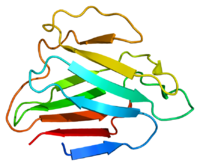
Photo from wikipedia
Simple Summary The biology of a multicellular organism is extremely complex, leaving behind a realm of compound yet systematic mechanisms still to be unraveled. The nucleus is a vital cellular… Click to show full abstract
Simple Summary The biology of a multicellular organism is extremely complex, leaving behind a realm of compound yet systematic mechanisms still to be unraveled. The nucleus is a vital cellular organelle adapted to storing and regulating the hereditary genetic information. Dysregulation of the nucleus can have profound effects on the physiology and viability of cells. This becomes extremely significant in the context of development, where the whole organism arises from a single cell, the zygote. Therefore, even a mild aberration at this stage can have profound effects on the whole organism. However, studying the function of individual nuclear components at this point is exceptionally complicated because this phase is inherently under the control of maternal factors stored in the female germ cell, the egg. Here, we focus on the lamins, as essential nuclear components, and summarize the current knowledge of their role in development. Although scientists encounter challenges working with these miniscule yet key proteins, the demand to know more is increasing gradually due to the mutations caused in lamins leading to irreversible phenotypic conditions in humans. Abstract Lamins are essential components of the nuclear envelope and have been studied for decades due to their involvement in several devastating human diseases, the laminopathies. Despite intensive research, the molecular basis behind the disease state remains mostly unclear with a number of conflicting results regarding the different cellular functions of nuclear lamins being published. The field of developmental biology is no exception. Across model organisms, the types of lamins present in early mammalian development have been contradictory over the years. Due to the long half-life of the lamin proteins, which is a maternal factor that gets carried over to the zygote after fertilization, investigators are posed with challenges to dive into the functional aspects and significance of lamins in development. Due to these technical limitations, the role of lamins in early mammalian embryos is virtually unexplored. This review aims in converging results that were obtained so far in addition to the complex functions that ceases if lamins are mutated.
Journal Title: Biology
Year Published: 2022
Link to full text (if available)
Share on Social Media: Sign Up to like & get
recommendations!